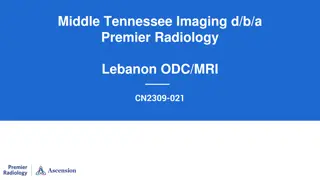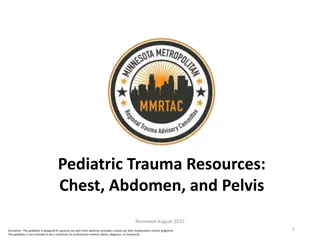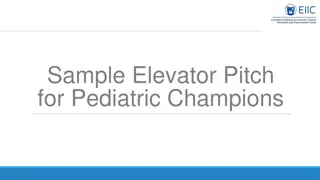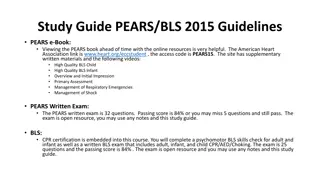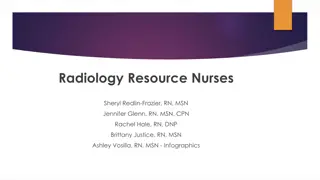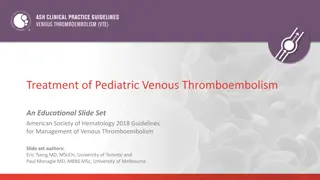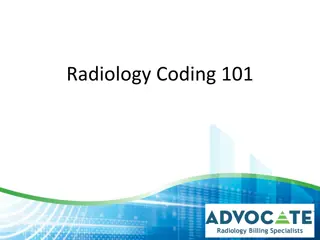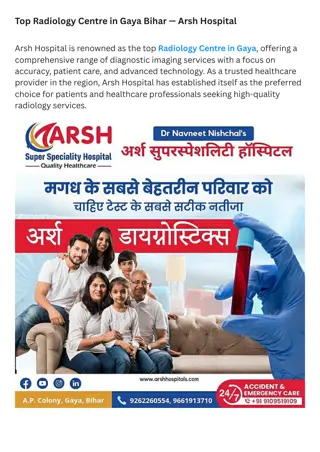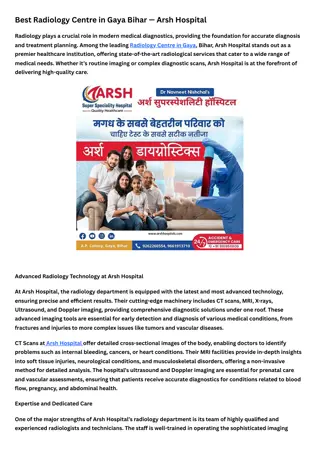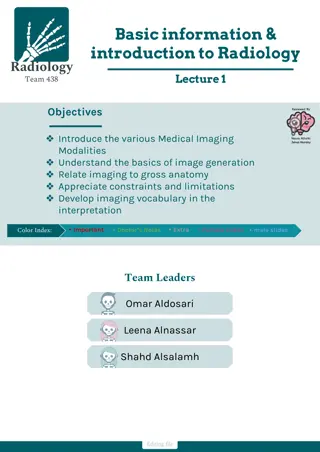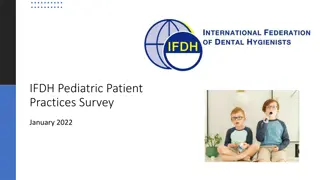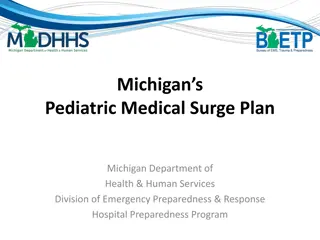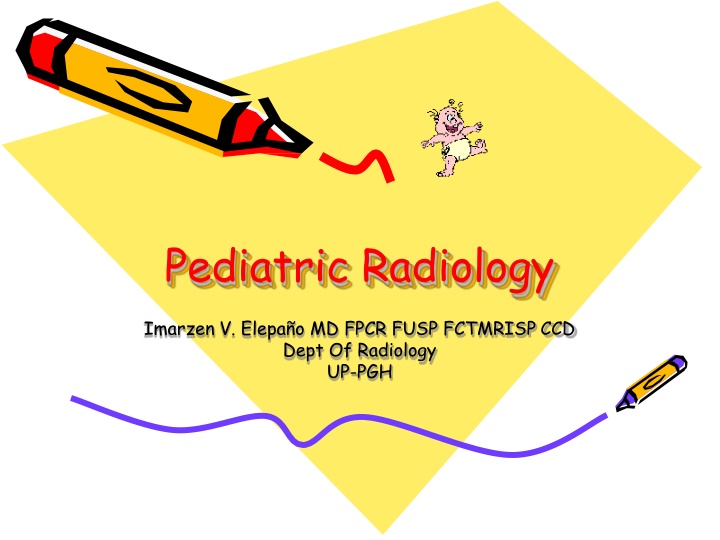
Pediatric Radiology, Children's Rights, and Health Care Law
Explore the importance of pediatric radiology, children's rights, and health care law in ensuring the well-being of young patients. Learn about immobilization, restraints, and European guidelines for quality diagnostic imaging in pediatrics. Discover the significance of upholding children's rights and best interests in medical settings.
Download Presentation

Please find below an Image/Link to download the presentation.
The content on the website is provided AS IS for your information and personal use only. It may not be sold, licensed, or shared on other websites without obtaining consent from the author. If you encounter any issues during the download, it is possible that the publisher has removed the file from their server.
You are allowed to download the files provided on this website for personal or commercial use, subject to the condition that they are used lawfully. All files are the property of their respective owners.
The content on the website is provided AS IS for your information and personal use only. It may not be sold, licensed, or shared on other websites without obtaining consent from the author.
E N D
Presentation Transcript
Pediatric Radiology Imarzen V. Elepa o MD FPCR FUSP FCTMRISP CCD Dept Of Radiology UP-PGH
Consent, immobilisation and health care law
Childrens rights Perceptions of children s rights are not universally consistent and it was the goal of the United Nations Convention on the Rights of the Child 1989 to clarify children s rights. Three important articles for health care workers within this convention are identified
From the United Nations Convention on the Rights of the Child. Article 3: In all actions concerning children, the best interests of the child shall be a primary consideration. Article 12: Parties shall assure to the child who is capable of forming his/her own views the right to express those views freely in all matters affecting the child, the views of the child being given due weight in accordance with age and maturity of the child. Article 24: Parties shall take all effective and appropriate measures with a view to abolishing traditional practices prejudicial to the health of children.
Immobilisation versus restraint The term restraint is generally reserved for use within the mental health setting. The more general terminology used within health care is immobilization .
To immobilize a person is to render them fixed or incapable of moving whereas restraint is the forcible confinement, limitation or restriction
European Guidelines on Quality Criteria for Diagnostic Radiographic Images in Paediatrics were issued. These guidelines state that patient positioning, prior to exposure to radiation, must be exact whether or not the patient co-operates. The guidelines advocate the use of physical restraints in the immobilization of young children and state that for infants, toddlers and young children, immobilization devices, properly applied, must ensure that the patient does not move and the correct projection is achieved
(1) Prepare child and guardian for procedure and explain their role (2) Invite guardian to be present (3) Use a specific room for painful procedures (4) Position child in a comforting manner (5) Maintain a calm and positive atmosphere
Little research has been published that evaluates techniques in holding and comforting children, even though it is generally agreed that all health professionals working with children need education and training into the immobilization and distraction of children
Prepare child and guardian Before the radiographic examination commences, both the child and guardian need to know why the examination is necessary, what the procedure will be and essentially what their role will be (i.e. what is expected of them).
Invite guardian to be present The presence of a guardian within the examination room provides the child with security and it has been found that 99% of 5 12 year-olds believe that the presence of their guardian will help reduce pain and anxiety.
Guardians are also able to : comfort the child in a familiar manner implement appropriate distraction techniques that can reduce the child s fear and anxiety, increase the child s co-operation and minimize the need for restraining devices.
Position child in a comforting manner Lying supine within an unfamiliar environment increases the feeling of helplessness and loss of control in adults and children alike and increases patient anxiety.
The need for cuddlesand comfort throughout an imaging examination is not restricted to very young children and children as old as 7 or 8 years will prefer to sit across a guardian s lap or next to a guardian to gain comfort from their presence
a) and (b) Sitting an older child next to the guardian allows them to feel comforted while still respecting their older status. The guardian can also assist with immobilization.
a) and (b) Sitting the child across the guardian s lap is a natural and comforting position for older children and permits some adult assistance with positioning and immobilization. Note the guardian and child are seated to the side of the table.
Seating a young child at the end of the table where they can lean in to the guardian is more comforting than being laid in the supine position and may be useful for examinations of the lower limb.
a) and (b) The straddle hold is a natural, comforting position for young children and naturally allows the guardian to successfully immobilize the child and assist in positioning.
(a) and (b) Projectors may be useful distraction tools within the x-ray room but care needs to be taken to ensure that they are positioned in a safe and appropriate place without electrical leads trailing across the room.
Maintain a calm, positive atmosphere If you talk to a screaming child quietly and positively then eventually they will calm down. Anxiety levels in children and adults increase with the level of surrounding noise and therefore focusing on a calm and quiet voice can help reduce this anxiety.
Distraction tools The use of distraction techniques within health care is growing greater in prominence and the experts in the use of distraction and play are play specialists. Alternatively, various pieces of equipment designed to distract children are available but care must be taken before purchase to ensure that they are easy to use and operate. Whatever the distraction tools used, it is essential that they be used only within the examination room to maintain their novelty value and maximize their effectiveness.
Radiation protection Radiation protection in diagnostic radiography is essential if medical exposure to ionizing radiation is to be maintained at a level of minimal acceptable risk. The concept of risk is an important one and it is essential that we reduce risks to patient and staff through the justification, optimization and limitation of radiation exposures
Patient positioning Incorrect positioning is the most frequent cause of inadequate radiographic image quality in paediatrics and should not be used as an excuse for substandard image quality
Field size and beam limitation Inappropriate field size is a common fault in paediatric radiographic technique and its correction is an effective method of reducing unnecessary dose to the patient. Correct beam limitation requires the radiographer to apply precise knowledge of external anatomical landmarks to the paediatric patient being examined. Reiterate the importance of accurate collimation to the area of interest as a method of reducing dose
Protective shielding For all paediatric examinations, the consistent use of lead rubber to shield that part of the body in immediate proximity to the diagnostic field is essential.
Understanding Radiation and Its Effect on Children
Every day each of us receives 1 millirad of radiation from environmental sources. The biggest contribution to environmental radiation comes from radon gas, which is a decay product in the uranium series. However, the largest source of radiation exposure resulting from human activity is diagnostic X-rays.
Since radiation is ubiquitous in our environment, why are we concerned about medical radiation? Firstly, the background dose is much lower than that of CT. There have never been proven deleterious effects secondary to normal background radiation.
Of those effects caused by radiation (genetic mutations, carcinogenesis, and cell death), the one we are most concerned about is carcinogenesis. There are a lot of data for radiation- induced cancer, both incidence and mortality
The incidence of cancer is 22.5 times greater than the mortality. The biological effects of radiation are greatest on the faster-growing organisms the fetus, infant, and young child. The thyroid gland, breast tissue, and gonads are organs with increased sensitivity in growing children.
A second factor in childrens vulnerability to radiation carcinogenesis is the life-long cumulative effect of radiation. The younger the patient and the more times he/she is exposed to radiation, the higher the probability of cancer.
The third factor which explains why children are at the greatest risk of radiation carcinogenesis is the fact that it takes a long time to develop a cancer and that children have the longest life span remaining after exposure.
The chest and upper respiratory tract Chest radiography is the most frequently performed paediatric plain film examination1 and may be requested to : assist in establishing a preliminary diagnosis, or to monitor the progression of a respiratory condition and assess the effectiveness of any implemented treatment.
Despite the relative frequency , it is still regarded as one of the most clinically challenging examinations to perform adequately and, as a result, many chest radiographs are of reduced image quality, in particular those undertaken on children under 6 years of age3
Chest Examinations in Children Normal inspiratory chest a Frontal examination reveals a normal lung volume. The criteria for a normal lung volume are: (a) less than one-third of the heart is projected below the hemidiaphragm; (b) the diaphragm is rounded, and the sixth or seventh anterior rib (ar) intersects the diaphragm; and (c) the lungs are air-filled (black).
This is a properly positioned, non- rotated film as evidenced by (1) comparative anterior ribs equidistant from the pedicles (p), (2) medial aspects of the clavicles (cl) symmetrically positioned, (3) the carina approximates the right pedicles (arrow), and (4) no difference in aeration between the two sides. The film was taken with the patient erect, as shown by the air fluid level in the stomach (arrowhead)
b Lateral examination confirms normal aeration of the lungs. Note that the vertebral bodies (vb) get blacker as we go from superior to inferior. The patient is slightly rotated as you can see the ribs on each side (arrows)
Technical Factors Technical problems in pediatric radiology are caused by: A largely by uncooperative children. The young patients are not feeling well, the environment is strange, and they may as a result be quite frightened.
Preliminary evaluation of the chest radiograph should assess these technical factors: The degree of inspiration: lung volume The position of the patient: extent of rotation and posture of the patient How the film was obtained Adequacy of the exposure
Lung Volume The radiographic examination of the chest begins with frontal and lateral roentgenographs taken after deep inspiration
If the child has taken a shallow breath: the heart may appear enlarged, the vessels may coalesce to give a false impression of an opacity, especially in the region of the bases and hila, and sometimes the radiograph has a hazy quality due to the influx of blood and lack of aerated lung.
Position of the Patient The position of the patient is determined by rotation and posture (lying, sitting, or standing). The child s posture is important.
When the patient is supine, the vascular supply to the upper and lower lobes is equal since gravity has no effect. When the child is sitting or standing, gravity plays a significant role, and the upper-lobe vessels are less distended than the lower-lobe vessels (one-third to two- thirds size).
One can determine an erect film by looking at the air fluid level in the stomach and at changes in the pulmonary vasculature.
c e These three films are in varying degrees of inspiration: c is an optimal inspiration; d is acceptable but less than average with the 5th anterior rib at the diaphragm; e shows complete expiration with almost a white-out of the lungs. It is important to appreciate the degree of inspiration so one can make an accurate determination of any pathology
The rotated chest asymmetric clavicles, differences in aeration , heart projected over one hemithorax and not the other, asymmetric ribs when relating the anterior rib to the pedicle The ribs are visible and not the spinous process
How the Film Was Obtained The third major technical factor to keep in mind is how the film was obtained. Greater magnification occurs when structures, such as the heart, are fartherfrom the film. When the X-ray beam passes through the patient from back to front [a posterior anterior (PA) projection], the heart is closer to the film and is less magnified.
Conversely, if the X-ray beam enters the front of the patient s chest, passes through the back and onto the film [an anterior posterior (AP) projection], the magnified heart and great vessels may give the impression of cardiomegaly.
Effect of patient position and the tube target distance a Patient in supine position, with approximately 46 in. (ca 1.2 m) between the X-ray tube and the film. Upper-lobe vessels (arrow) are equal in size to those of the lower lobe (arrow). The heart is magnified. There is a central venous catheter in place b Patient is erect and 6 ft (ca 1.8 m) from the X-ray tube. It is difficult to see the upper lobe vessels, but the lower lobe vessels are easily seen

